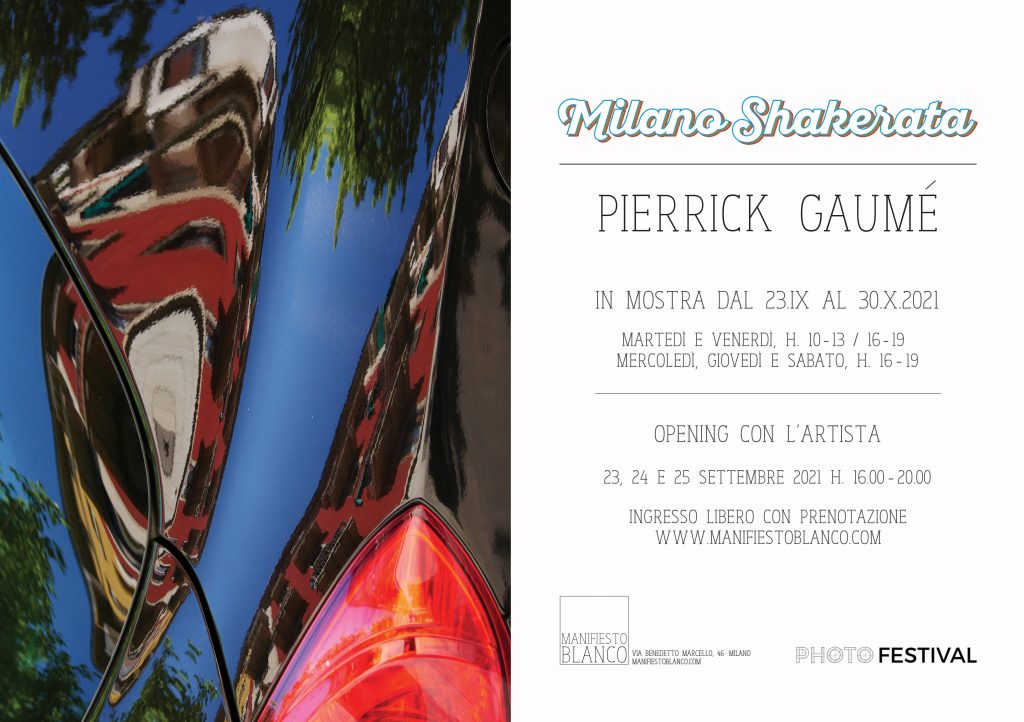
In occasione della XVI edizione di Milano Photofestival, la galleria Manifiesto Blanco propone un inedito progetto fotografico site-specific di Pierrick Gaumé. Il progetto Milano Shakerata – dedicato al capoluogo lombardo – si basa sul concetto di automorfosi, che deriva dalla fusione del termine greco antico Autós, cioè se stesso, con il termine Mórphôsis, cioè prendere forma.
Questa serie fotografica potrebbe essere interpretata semplicemente come delle immagini di automobili o di riflessi dell’architettura di Milano, deformati dalle superfici delle carrozzerie. Tuttavia queste fotografie mostrano anche dei riflessi con caratteristiche irregolari nei vari piani, volumi curvilinei e aerodinamici che suggeriscono una rappresentazione insolita dello spazio che li circonda. Questi piani e queste linee inevitabilmente definiscono – se non ridefiniscono – visioni invertite e distorte dello spazio urbano. Elementi architettonici contorti e frammentati da linee strutturali, a volte, generano un’esplosione di forme. Le loro numerose sfaccettature sono sempre più evidenti man mano che ci si lascia coinvolgere dalla suggestione della serie Milano Shakerata. Da quel momento, dalle immagini emergono luci e blocchi di colore, sparsi o ordinati su vari livelli, a volte con un punto focale che si alza e che sembra ardere come un’esplosione.
Nella serie esposta, ogni immagine fotografica di Pierrick Gaumé suscita una percezione dinamica della compenetrazione tra i volumi degli oggetti e il loro ambiente fisico. Focalizzare l’attenzione su questo rapporto può far pensare ad opere del movimento cubista nella sua fase analitica, ma anche ad alcune del Futurismo italiano. I segni esistenti della realtà urbana appaiono ora articolati o slegati, ora decostruiti o remixati da oggetti-specchio deformanti in una visione “surreale” puramente visiva. Accolto e osservato dall’autore, questo fenomeno ottico gli consente di catturare la realtà della trasformazione in forme, luci e colori che offrono la nuova visione di uno spazio urbano graficamente ricomposto.Prive di qualsiasi genere di fotoritocco, le automorfosi di Gaumé non derivano da una ricostruzione mentale o intellettualizzata della realtà. In altre parole, si può affermare che sono reali quanto lo è la realtà.
With the opportunity of Milan’s Photofestival, the Manifiesto Blanco gallery chooses to unveil an unprecedented, site-specific photography project from Pierrick Gaumé. This project, named Milano Shakerata, is dedicated to the city of Milan and based on the photographer’s concept of automorphoses — from the ancient Greek term Autós, i.e. itself, and the term Mórphôsis, i.e. taking shape.
In this series of images, some people could see photographs of cars or photographs that show reflections of Milan’s architecture, distorted on automotive bodywork surfaces. However, these images also show reflections with irregular characteristics in the various planes, curvilinear and aerodynamic volumes that convey an unusual representation of the space surrounding them. Consequently, these planes and lines unavoidably define — if not redefine — inverted and distorted visions of urban space. Twisted city elements, fragmented with structural lines, sometimes generate an outbreak of shapes. Their many facets can be discovered as the Milano Shakerata series unfolds. Thereafter, scattered or orderly highlights and colour blocks emerge on various levels, sometimes with a focal point that rises up and looks as ardent as a fireburst.
As a whole, these photographic images from Pierrick Gaumé offer a dynamic perception of the interpenetration between volumes of objects and their physical environment. Focusing on this interpenetration relationship can recall works of the Cubist movement in its analytical phase, but also some from Italian Futurism. Existing signs of urban reality look both articulated and unknotted, both deconstructed and remixed by distorting mirror-objects in a “surreal” vision that is purely visual. Embraced and observed by the author, this optical phenomenon enables him to capture the reality of transformation in shapes, lights and colours that offer the new vision of a graphically-recomposed urban space.
Since Gaumé rules out to retouch his automorphoses, one can confirm these photographs do not result from a mental or intellectualised reconstruction of reality. In other words, they are as real as reality is.
